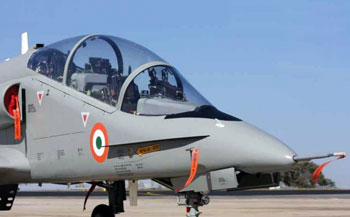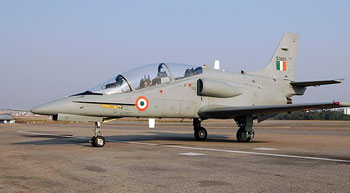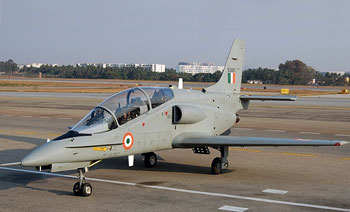INDIAN ARMED FORCES CHIEFS ON
OUR RELENTLESS AND FOCUSED PUBLISHING EFFORTS

SP Guide Publications puts forth a well compiled articulation of issues, pursuits and accomplishments of the Indian Army, over the years

I am confident that SP Guide Publications would continue to inform, inspire and influence.

My compliments to SP Guide Publications for informative and credible reportage on contemporary aerospace issues over the past six decades.
- Prime Minister witnesses 'Bharat Shakti' – a Tri-Services Firing and Manoeuvre Exercise in Pokhran, Rajasthan
- Interim Defence Budget 2024-25 — An Analysis
- Union Defence budget 2024
- Prime Minister Modi Commemorates Indian Navy Day in a Grand Ceremony
- Prime Minister Modi Flies in the LCA Tejas
- New Chapter in India-Italy Defence Ties
- Airpower beyond Boundaries
IAF floats RFI on intermediate trainer



The inevitable has happened. With the Hindustan Aeronautics Ltd HJT-36 intermediate jet trainer delayed beyond the IAF's planned induction schedule, a global RFI has been floated requesting global OEMs to pitch their products for a possible future acquisition. The IAF currently has Pilatus PC-7 Mk-II trainers for basic training and Hawk Mk.132 trainers for advanced lead-in training. With its ageing Kirans on their way out, the IAF desperately needs new intermediate Stage-II trainers to fill the yawning gap. HAL's HJT-36 was to have joined the training fleet in June 2012, but has been delayed for a plethora of reasons, including a series of accidents and so-far insurmountable odds in proving crucial safety and recovery features in field trials.
In the RFI, the IAF has stipulated that the aircraft should be easy to fly and have good control response/agility. The flying qualities should preferably conform to Mil-F-8785C and Mil Std 1797-A. The aircraft should demonstrate the following qualities: (a) Stalling. An unmistakable natural stall warning should be available, irrespective of the configuration. (b) Spinning. The aircraft must be resistant to spin but it should be possible to perform intentional spin up to six turns to either side and recover safely thereafter. The aircraft behaviour in the spin should be predictable and consistent. (c) Aerobatics The IJT should be capable of performing loops, barrel rolls, rolls, combination manoeuvres and negative ‘g’ flight without adverse effects on the engine and aircraft structure. The aircraft should be capable of sustained inverted flight for at least 30 seconds at sea level at maximum take-off power.
The aircraft has also been specifically described as a counter-insurgency platform in the RFI. To that end, the IAF has also stipulated that the aircraft should be capable of carrying at least 1000 kg of external load. The aircraft should be equipped with a minimum of five hard points and each hard point on the wing should be stressed to carry at least 300 kg stores. The aircraft should be free from buffet, dutch roll, snaking and wing rock during air to ground weapon training. The aircraft should be capable of employing the following armament: (a) Gun. A light weight gun/ gun-pod with adequate ammunition for at least five seconds of firing time. (b) Rocket Pods. Reusable rocket pods. (c) Bombs. Should be able to carry at least 4x250 kg retarded or ballistic bombs. The stations should be capable of employing Carrier Bomb Light Stores (CBLS) type of dispensers for carriage of practice bombs (25 lbs and three Kg).
Given concerns over the performance of the HJT-36, the IAF has gone into great detail over the flight envelope requirements of the desired aircraft. According to the RFI, the aircraft should be safely operable accelerations of up to +7.0 g and -2.5 ‘g’ in Normal Training Configuration* (NTC). With external stores (other than empty Drop tank) the aircraft should be cleared for operations at accelerations up to +5g and -1.5g. Service ceiling should be at least 9000m. In the NTC, the maximum speed in flight must not be less than 750 kmph CAS and the ac should not display any marked compressibility effects up to 0.75 M. The maximum sustained speed at sea level must be at least 700 kmph in NTC and 550 kmph at maximum AUW. In clean configuration, the 1’g’ stalling speed must not exceed 175 kmph with all services retracted. In the NTC, the IJT should have a glide ratio of 1:12 or better.
Vendors likely to respond to the RFI by April 4 include Yakovlev, Alenia Aermachhi, Korea Aerospace Industries (KAI), Boeing, Saab, Northrop-Grumman and Beechcraft.





